
The Trifid Nebula is an H II region in the north-west of Sagittarius in a star-forming region in the Milky Way's Scutum–Centaurus Arm. It was discovered by Charles Messier on June 5, 1764. Its name means 'three-lobe'. The object is an unusual combination of an open cluster of stars, an emission nebula, a reflection nebula, and a dark nebula. Viewed through a small telescope, the Trifid Nebula is a bright and peculiar object, and is thus a perennial favorite of amateur astronomers.

In stellar evolution, an FU Orionis star is a pre–main-sequence star which displays an extreme change in magnitude and spectral type. One example is the star V1057 Cyg, which became six magnitudes brighter and went from spectral type dKe to F-type supergiant during 1969-1970. These stars are named after their type-star, FU Orionis.

Meissa, designated Lambda Orionis is a star in the constellation of Orion. It is a multiple star approximately 1,300 ly away with a combined apparent magnitude of 3.33. The main components are an O8 giant star and a B-class main sequence star, separated by about 4″. Despite Meissa being more luminous and only slightly further away than Rigel, it appears 3 magnitudes dimmer at visual wavelengths, with much of its radiation emitted in the ultraviolet due to its high temperature.

The Orion molecular cloud complex is a star-forming region with stellar ages ranging up to 12 Myr. Two giant molecular clouds are a part of it, Orion A and Orion B. The stars currently forming within the complex are located within these clouds. A number of other somewhat older stars no longer associated with the molecular gas are also part of the complex, most notably the Orion's Belt, as well as the dispersed population north of it. Near the head of Orion there is also a population of young stars that is centered on Meissa. The complex is between 1 000 and 1 400 light-years away, and hundreds of light-years across.
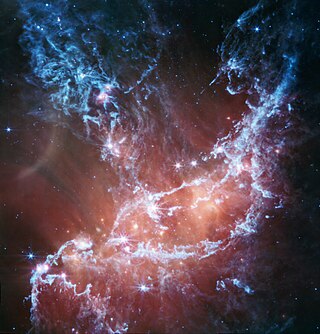
NGC 346 is a young open cluster of stars with associated nebula located in the Small Magellanic Cloud (SMC) that appears in the southern constellation of Tucana. It was discovered August 1, 1826 by Scottish astronomer James Dunlop. J. L. E. Dreyer described it as, "bright, large, very irregular figure, much brighter middle similar to double star, mottled but not resolved". On the outskirts of the cluster is the multiple star system HD 5980, one of the brightest stars in the SMC.

NGC 1333 is a reflection nebula located in the northern constellation Perseus, positioned next to the southern constellation border with Taurus and Aries. It was first discovered by German astronomer Eduard Schönfeld in 1855. The nebula is visible as a hazy patch in a small telescope, while a larger aperture will show a pair of dark nebulae designated Barnard 1 and Barnard 2. It is associated with a dark cloud L1450. Estimates of the distance to this nebula range from 980–1,140 ly (300–350 pc).

NGC 2244 is an open cluster in the Rosette Nebula, which is located in the constellation Monoceros. This cluster has several O-type stars, super hot stars that generate large amounts of radiation and stellar wind.

Z Canis Majoris (Z CMa) is a B-type star in the constellation of Canis Major. It has an average apparent visual magnitude of approximately 10, though has brightened by 1-2 magnitudes in irregular outbursts in 1987, 2000, 2004 and 2008.

AFGL 2591 is a star forming region in the constellation Cygnus. Its dense cloud of gas and dust make its interior invisible to optical telescopes. Images in the infrared show a bright young stellar object, with an associated reflection nebula seen as a glowing cone projecting from the young star. A cluster of stars is forming within the molecular cloud, but most of the infrared radiation is coming from this star, AFGL 2591-VLA3.
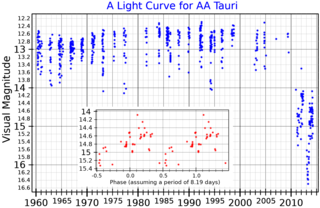
AA Tauri is a young variable star in the equatorial constellation of Taurus, located in the Taurus-Auriga star-forming region. It is too faint to view with the naked eye, having an apparent visual magnitude that varies from 12.2 down to 16.1. The star is located approximately 439 light-years away from the Sun based on parallax, and is drifting further away with a radial velocity of +17 km/s.

The Lambda Orionis Cluster is an open star cluster located north-west of the star Betelgeuse in the constellation of Orion. It is about five million years old and roughly 1,300 ly (400 pc) away from the Sun. Included within the cluster is a double star named Meissa. With the rest of Orion, it is visible from the middle of August in the morning sky, to late April before Orion becomes too close to the Sun to be seen well. It can be seen from both the northern hemisphere and the southern hemisphere.

25 Orionis, less commonly known by its Bayer designation Psi1 Orionis is a fifth-magnitude star in the constellation Orion. It lies among a dense cluster of low-mass pre-main-sequence stars in the Orion OB1a.

Pi1 Orionis (π1 Ori, π1 Orionis) is a star in the equatorial constellation of Orion. It is faintly visible to the naked eye with an apparent visual magnitude of 4.74. Based upon an annual parallax shift of 28.04 mas, it is located about 116 light-years from the Sun.

69 Orionis is a single star in the equatorial constellation of Orion, positioned a couple of degrees to the north of Xi Orionis. It has the Bayer designation f1 Orionis; 69 Orionis is the Flamsteed designation. The star is visible to the naked eye as faint, blue-white hued point of light with an apparent visual magnitude of 4.92. It is located approximately 530 light-years from the Sun based on parallax, and is drifting further away with a radial velocity of +22 km/s. In 2015, H. Bouy and J. Alves suggested that it is a member of the newly discovered Taurion OB association.

Phi1 Orionis is a binary star system in the constellation Orion, positioned less than a degree to the south of Meissa. It is visible to the naked eye with an apparent visual magnitude of 4.42. The distance to this system, based upon an annual parallax shift of 3.0 mas, is around 1,090 light-years.

Phi2 Orionis is a star in the constellation Orion, where it forms a small triangle on the celestial sphere with the nearby Meissa and Phi1 Orionis. This star is visible to the naked eye with an apparent visual magnitude of 4.081. Based upon an annual parallax shift of 28.67 mas, it is located around 114 light-years from the Sun.
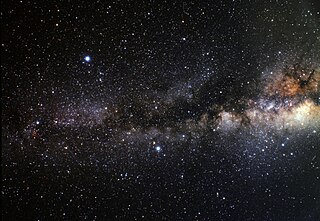
The Serpens–Aquila Rift (also known as the Aquila Rift) is a region of the sky in the constellations Aquila, Serpens Cauda, and eastern Ophiuchus containing dark interstellar clouds. The region forms part of the Great Rift, the nearby dark cloud of cosmic dust that obscures the middle of the galactic plane of the Milky Way, looking inwards and towards its other radial sectors. The clouds that form this structure are called "molecular clouds", constituting a phase of the interstellar medium which is cold and dense enough for molecules to form, particularly molecular hydrogen (H2). These clouds are opaque to light in the optical part of the spectrum due to the presence of interstellar dust grains mixed with the gaseous component of the clouds. Therefore, the clouds in the Serpens-Aquila Rift block light from background stars in the disk of the Galaxy, forming the dark rift. The complex is located in a direction towards the inner Galaxy, where molecular clouds are common, so it is possible that not all components of the rift are at the same distance and physically associated with each other.
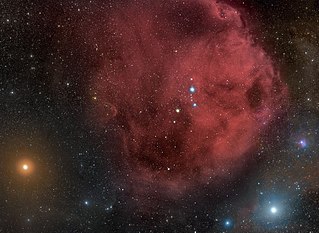
Sharpless 264, also known as the Lambda Orionis Ring, is a molecular cloud and H II region, which can be seen in the northern region of the Orion molecular cloud complex (OMCC), in the constellation of Orion. The OMCC is one of the best-known star formation regions and the closest sector of the Milky Way to the Solar System where high-mass stars are born. The nebula is named after its main star, λ Orionis, a blue giant responsible for the ionization of the surrounding material. It is also sometimes called the Angelfish Nebula due to its resemblance as to its lighter areas to an angelfish. In the infrared its ionized boundaries are that which appears, instead.
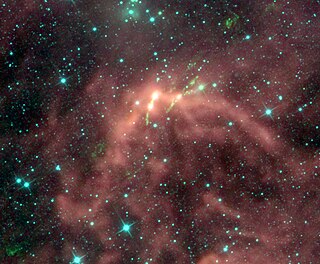
The dark nebula Barnard 203 or Lynds 1448 is located about one degree southwest of NGC 1333 in the Perseus molecular cloud, at a distance of about 800 light-years. Three infrared sources were observed in this region by IRAS, called IRS 1, IRS 2 and IRS 3.

UX Orionis is a variable star in the constellation of Orion. It is a Herbig Ae star, located about 1000 light years from the Earth. At its brightest it is a magnitude 9.5 object, so it is too faint to be seen with the naked eye. UX Orionis is the prototype of the UX Orionis class of variable stars, which are young stellar objects that exhibit large, irregular changes in visual band brightness. UX Orionis was discovered by Henrietta Swan Leavitt.


















